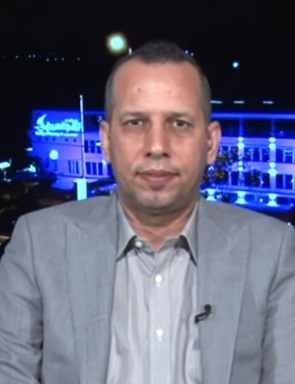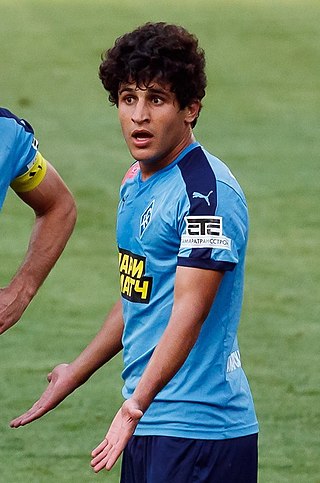
|thumb|Safaa Al Sarai]]
Safaa Al Sarai (Arabic : صفاء السراي; 28 June 1993 – 28 October 2019) [1] was an Iraqi activist who has been called the icon of the Iraqi tishreen protests. [2]

|thumb|Safaa Al Sarai]]
Safaa Al Sarai (Arabic : صفاء السراي; 28 June 1993 – 28 October 2019) [1] was an Iraqi activist who has been called the icon of the Iraqi tishreen protests. [2]
He was born into a family from Baghdad that lived in the Sha'ab neighborhood. He graduated from high school to enroll in the Technological University, and during his school years he worked as a porter in a market in the Jamila commercial district. His father died early in his life, then his mother died from cancer in 2017. He later graduated as a programmer from the department of computer science at the University of Technology. After graduating, he worked in writing petitions in front of one of the buildings of the Traffic Directorates. [3] And a week before his death, he got a new job in his specialty, when he was employed at a private university. Safaa Al Sarai wrote popular and eloquent poetry on a small scale. He was also a skilled painter, and in poetry, he showed unrivalled admiration for the Iraqi poet Muzaffar al-Nawab. He participated in the "I am Iraqi, I Read 2018" festival, and painted paintings of Iraqi national symbols such as Zaha Hadid, Muzaffar al- Nawab, Muhammad Mahdi al-Jawahiri, Badr Shaker al-Sayyab and many others. [4]
He participated in the 2011 demonstrations in Tahrir Square, and in 2015, during the era of Prime Minister Haider al-Abadi, he participated in the 31 July demonstrations in Baghdad. He was arrested in 2018 for his participation in the demonstrations in poorer areas in eastern Baghdad and was released afterwards. Safaa started receiving threats to discourage him from participating in demonstrations and civil protests. [5] [6] [7]
Before his death, he wrote a letter titled to the Popular Mobilization Forces, praising their sacrifices, and warning them of a scheme in which they were intended to participate in suppressing the demonstrations, hours after the statement of the Deputy Chairman of the Popular Mobilization Authority, Abu Mahdi al-Muhandis, in which he said that his forces would intervene at the appropriate time, the last of what he wrote: "Shame on you." [8]
He was injured on Monday evening (28 October 2019) in the center of Liberation Square, while security forces fired gas bombs on the square. He was transferred to the Al-Jumla Al-Asabia Hospital, and doctors performed an operation for him in which they removed the gas bomb fragment from his head and stopped the bleeding. However, his condition remained critical, and he died of his wounds. His body was taken to Liberation Square after the athan for the fajr prayer despite the curfew, and his friends carried him under the Freedom Monument in the middle of the square during the early dawn hours, and the mourners chanted "Thanwah," with the words "Raise his head, O Thanwah Abinj." [9]
The BBC counted him among the five most important faces of protest around the world. [10]
Walid Jumblatt, leader of the Progressive Socialist Party in Lebanon, condemned his death, saying: "The martyrs do not go to heaven. They roam the heavenly books, each in his own way, like a bird, a star or a cloud. They appear to us every day and cry for us, we who are still in the hell that they tried to extinguish with their blood." [11]
Rusafa or Al-Rasafa is one of the nine administrative districts in Baghdad, Iraq, on the eastern side of the River Tigris. It is one of the old quarters of Baghdad, situated in the heart of the city, The Rasafa side is one of the main parts of the city of Baghdad, the capital of Iraq. Along with Karkh, it forms the essential components of the city, with the Tigris River flowing between them. The Rasafa side is known for its numerous cultural and historical landmarks, including the Old City, the Republic Bridge, and various markets and residential areas. and is home to a number of public squares housing important monumental artworks.

Al-Rashid Street is one of the main avenues in downtown Baghdad, Iraq. Named after Abbasid Caliph Harun al-Rashid, it is one of the most significant landmarks of the city due to its political, spiritual, urban, and cultural history. Located near al-Maidan Square, the boulevard is considered an important urban heritage site of Baghdad and bears witness to what Iraq has gone through in terms of political events, intellectual stature, and commercial success that Iraq saw over the course of more than a century, As well as being a tourist attraction. The street includes many historic landmarks such as Haydar-Khana Mosque, the Murjan Mosque, al-Zahawi Café, and Souk al-Haraj.
Esraa Ali Abdul Hussein Kadhim Aljubouri, better known as Esraa Alaseel, is an Iraqi singer-songwriter, best known for her songs "Abu Elbanat" and "Matseer Ilak Kul Chara".

Al-Sarai Mosque, also known as Hassan Pasha Mosque or Al-Nasr li-Din Allah Mosque, is a historic Sunni Islamic mosque located in Baghdad, Iraq, in the south of al-Rusafa. The mosque was first laid by 34th Abbasid Caliph al-Nasir in 1193 CE. The mosque was also nicknamed "The King's Mosque" because it was where the old Iraqi Kings prayed during the Royal Era.

The Haydar-Khana Mosque is a historic mosque located near al-Mutanabbi Street in Baghdad, Iraq, built by al-Nasir during the Abbasid Caliphate. The mosque is situated on al-Rashid Street and is located in the Haydar-Khana locality surrounded by buildings, shrines, and cafés. The mosque is an important historic landmark that reflect the society of Baghdad, intellectual gatherings, and fueling enthusiasm for demonstrations.

Al-Khilani Mosque is a historic Shi'ite mosque located in Baghdad, Iraq. Heading from the direction of al-Jumhuriya Street, the mosque has an old shrine within it, with a tomb of controversial identification.

Hisham al-Hashimi was an Iraqi historian and researcher in security and strategic affairs and extremist groups, and a specialist on the subject of the Islamic State and its supporters. He also was an advisor to the Iraqi government on counter-terrorism.

Safaa Hadi is an Iraqi footballer who plays as a midfielder for Persian Gulf Pro League club Tractor.
Hawa Baghdad is an Iraqi television show produced by Al Sharqiya.

Muhaned Abu Khumra is an Iraqi director, writer, and producer. He is most prominently known for creating the television series Hawa Baghdad. His TV series became one of the most famous TV series in Iraq. His show has been broadcast on Al-Sharqiya.

The Baghdad Observer was the official Iraqi-government English-language political daily newspaper that was issued continuously between 1967 and 2003. During that period, due to the popularity of the English language worldwide and due to the official nature of that newspaper it used to be the newspaper most-cited by non-Iraqi politicians and journalists covering Iraqi issues. It also used to be one of the most influential English-language newspapers published in Iraq.

Aya Mansoor, is an Iraqi poet, writer, and journalist. She published four books: Fingers' Forest, Alone She Sings, Alice in Baghdad, and Sunny Picture, and a play called Invisible. She also written many articles in different newspapers and magazines such as Al-Jazeera Net, Iraqi Network Magazine, Al-Sabah Iraqi Journalist, and Yalla news website.
In the history of Baghdad, the period from 1638 to 1704 began with the Fall of Baghdad after the Ottoman Empire occupied the city from the Safavid. It ended with the Hasan Pasha got power and also became the first Mamluk ruler of Baghdad on 1704. Kashik Hassan Pasha was a first Ottoman Governor of Baghdad, and Youssef Pasha was the last

Ali Al-Ghurairi is an Iraqi army general, commanding general, and chief of police, who currently serves as Director-General Commander of Police of the capital Baghdad. He has a jurist JD degree in law. He previously served as the Chief of staff of the Iraqi Federal Police Forces Command, Director-General of Directorate of Recruitment Management in Ministry Of Defense, Director of the administrative affairs of the Joint Staff, Director of Training in MOD, and Director of Administration in MOD.
Sayyid Hashim Al-Witry M.D. was an Iraqi physician and author born in Baghdad. He was one of the founders of the Royal College of Medicine of Iraq in which he worked in as a professor and dean. He was a key contributor to the establishment of the Iraq Academy, of which he was vice president then president for two periods: 1938; and 1943 to 1953. He was an elected member of the Iraqi Academy of Science and a second Vice President to the academy. He also re-established the House of Wisdom "Bayt Al-Hikma, Scientific institution intellectual" and was its president from 1953 to 1958.
Safa Diab an Iraqi writer and author, born in 1975 in Iraq. He obtained a bachelor's degree in Arabic literature from the University of Baghdad, after neglecting his studies at the University of Technology because of his love of studying literature and arts. He is a member of the Iraqi Writers Union.

The 17th of Ramadan Mosque is a mosque in al-Rusafa, Baghdad, in the eastern Karrada district, opposite al-Firdos Square, in front of the Ishtar Hotel. The mosque dates back to the royal era of Iraq and is considered an important historical landmark since it's located in a significant square in the city.

Al-Zahawi Café is a heritage café located in al-Rasheed Street between al-Maidan Square and Haydar-Khana Mosque near al-Mutanabbi Street in Baghdad, Iraq. The café is one of the oldest traditional cafés in Iraq with its establishment dating back to 1917. Named after the Iraqi poet and philosopher Jamil Sidqi al-Zahawi, the café is one of the more well-known coffeehouses of Baghdad and housed many intellectuals, poets, singers, and journalists over its existence although it has declined in recent years since 2003.

Umm al-Tabul Mosque is a large mosque located in Baghdad, Iraq, that was built in commemoration of the officers participating in the 1959 Mosul uprising. The mosque is located in the Yarmouk neighborhood and is notable for its unique architecture which takes inspiration from Islamic Egyptian architecture, specifically the Citadel of Saladin in Cairo. It is one of the closest mosques to the Baghdad International Airport.

Al-Khilani Square is a roundabout located in al-Rusafa side of Baghdad, Iraq. The square is home to many markets and departments as well as al-Khilani Mosque where the square got its name. In addition, the square is located in the center of various important streets that lead to important centers such as al-Jumhuriya Street which leads to the Shorja area, the street that leads to al-Sinak Bridge, and al-Tahrir Square which is 500 meters away. In recent years, the square saw many demonstrations taking place in it.